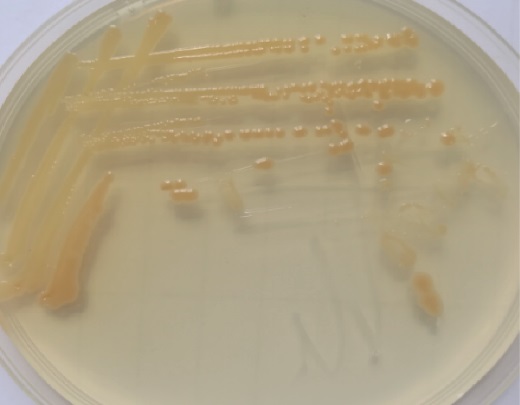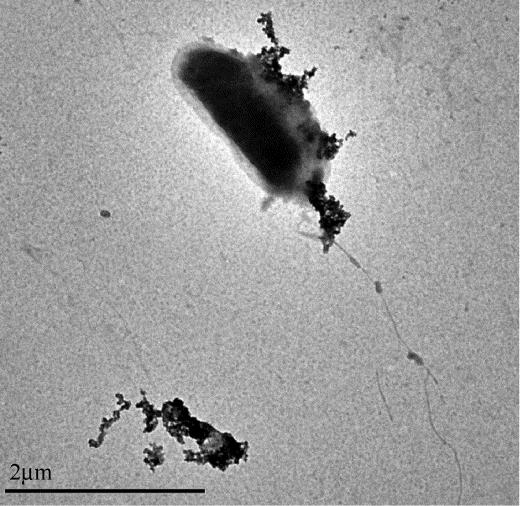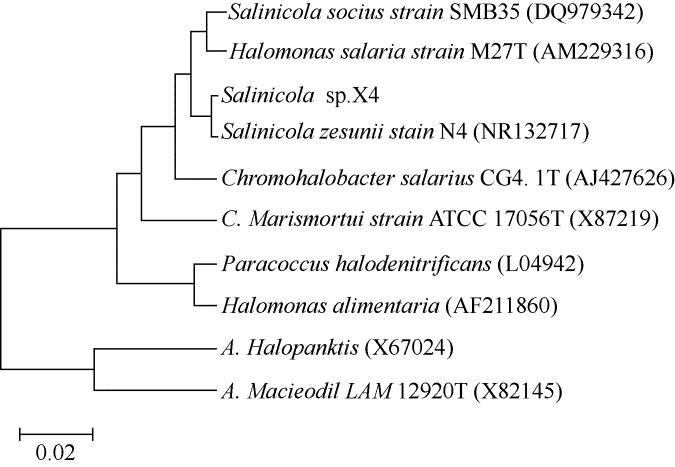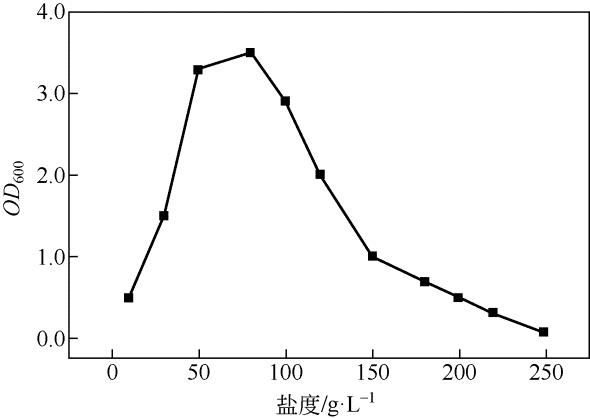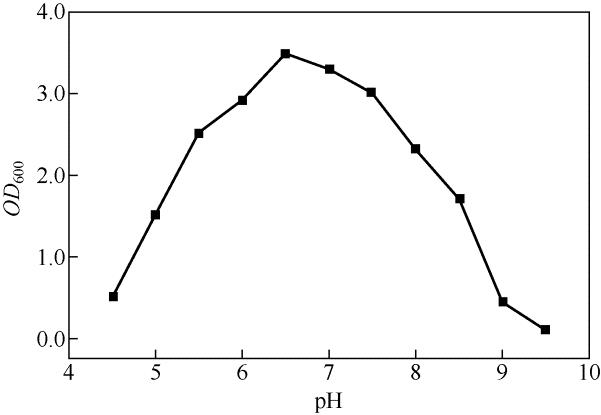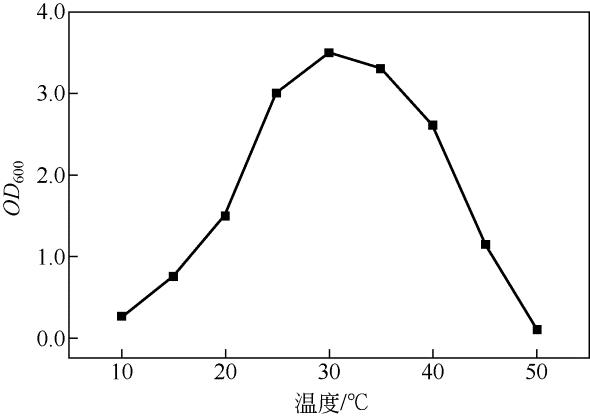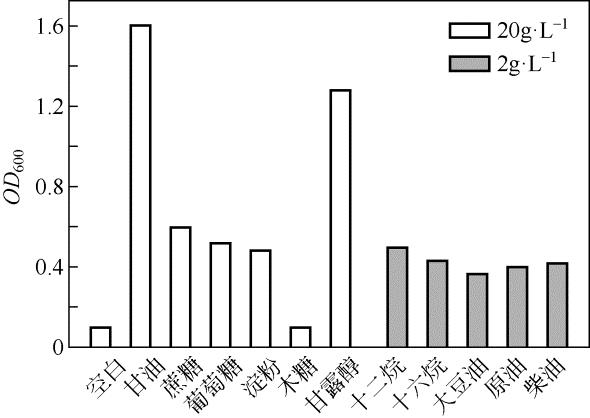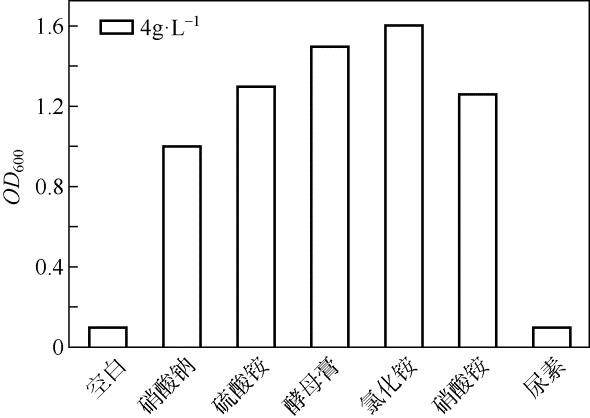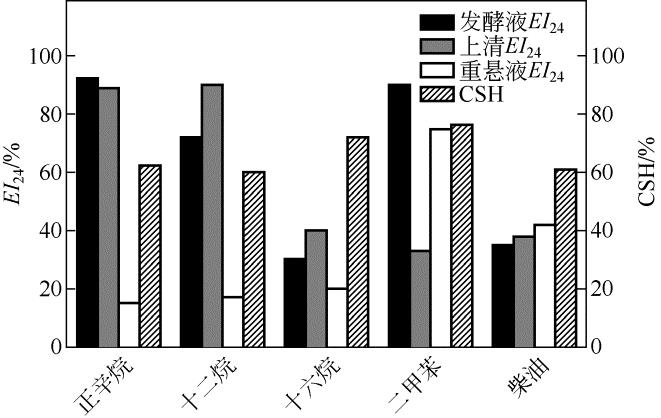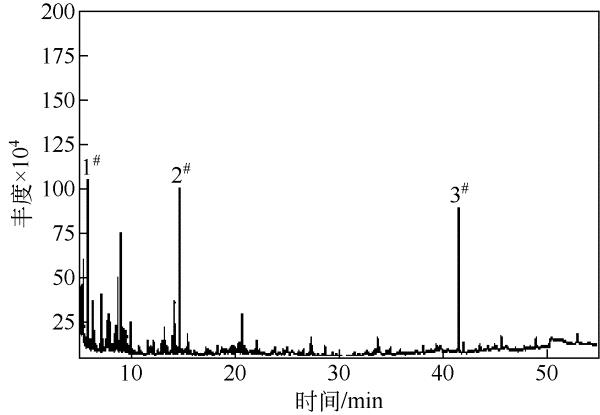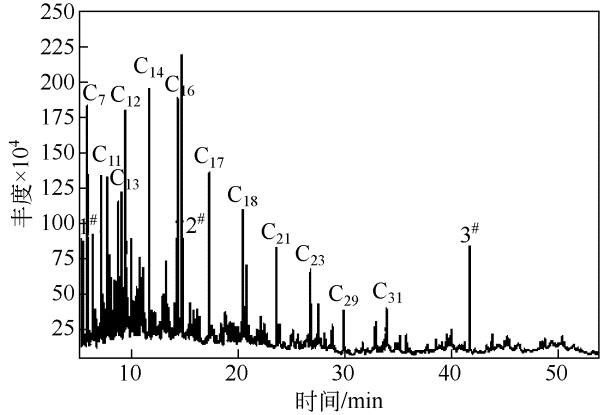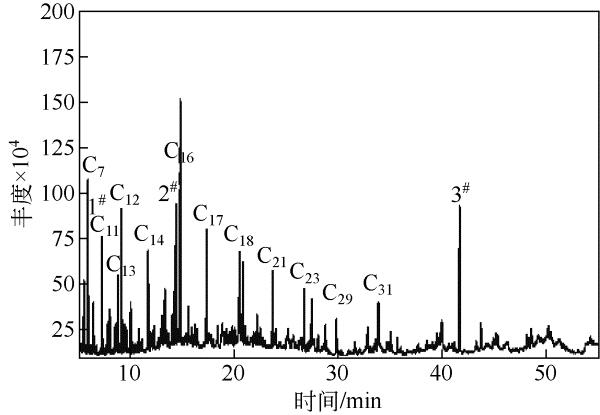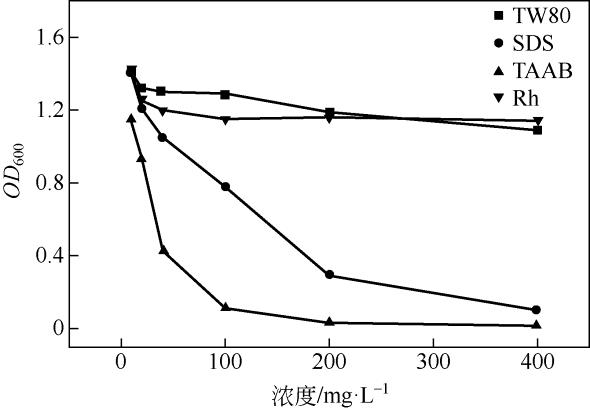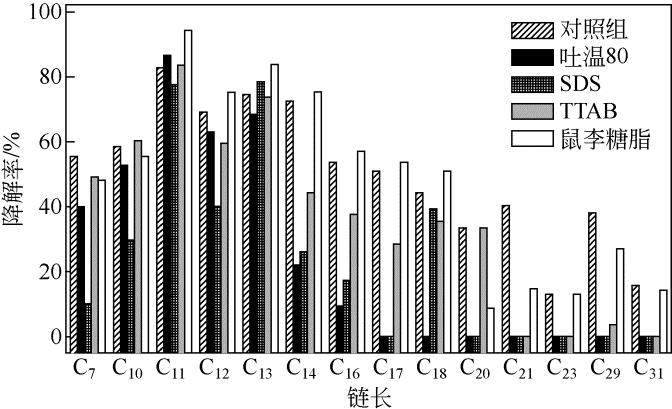化工进展 ›› 2019, Vol. 38 ›› Issue (04): 1894-1902.DOI: 10.16085/j.issn.1000-6613.2018-1456
一株中度嗜盐菌Salinicola sp.在高盐环境中的烷烃降解特性
- 南京工业大学生物与制药工程学院,江苏 南京 210009
-
收稿日期:2018-07-16修回日期:2018-10-10出版日期:2019-04-05发布日期:2019-04-05 -
通讯作者:李霜 -
作者简介:林佳辉(1995—),男,硕士研究生,研究方向为微生物学。E-mail:<email>806087308@qq.com</email>。|李霜,教授,博士生导师,研究方向为环境微生物。E-mail:<email>lishuang@njtech.edu.cn</email>。 -
基金资助:国家自然科学基金(51774188);江苏省先进生物制造协同创新中心项目(XTD1824)
Alkanes degradation characteristics of a moderately halophilic bacterium Salinicola sp. in a high salinity environment
Jiahui LIN( ),Dan WANG,Shuang LI(
),Dan WANG,Shuang LI( )
)
- College of Biotechnology and Pharmaceutical Engineering, Nanjing Tech University, Nanjing 210009, Jiangsu, China
-
Received:2018-07-16Revised:2018-10-10Online:2019-04-05Published:2019-04-05 -
Contact:Shuang LI
摘要:
从青海油田附近被石油污染的土壤中分离得到一株可利用原油为唯一碳源的菌株,将其命名为X4菌株。经16SrDNA分析鉴定,该菌株与中度嗜盐菌Salinicola zeshunii strain N4T(GenBank序列号为EU056581)同源性高达99%。X4菌株的最适温度为30℃,最适盐度为8%,最适pH为6.5,最佳碳源为甘油,最佳氮源为氯化铵。该菌可产生生物乳化剂,具有较强的细胞疏水性,对正辛烷、十六烷、二甲苯等典型烃类物质具有良好的乳化能力,细胞CSH值达到60%以上。在含5%盐度的无机盐培养基中,以3g/L的柴油为唯一碳源,采用GC-MS定量分析X4菌株的烃降解特征,结果表明菌株X4培养5天后柴油的总降解率达56%,菌株X4优先降解中长链烃类;C7~C13烃类的平均降解率为64.1%,C14~C20烃类的平均降解率为52.3%,C21~C31烃类的平均降解率约26.8%。离子型表面活性剂TTAB和SDS对X4菌株生长具有较强的毒性:在浓度达到100mg/L和400mg/L时能完全抑制菌体生长;在40mg/L的浓度下,使得菌株对柴油的降解率降低到20%。而X4菌株对非离子型表活剂——吐温80和生物表面活性剂——鼠李糖脂的耐受浓度均可达400mg/L。鼠李糖脂是嗜盐菌X4菌株的合适复配表活剂。
中图分类号:
引用本文
林佳辉, 王丹, 李霜. 一株中度嗜盐菌Salinicola sp.在高盐环境中的烷烃降解特性[J]. 化工进展, 2019, 38(04): 1894-1902.
Jiahui LIN, Dan WANG, Shuang LI. Alkanes degradation characteristics of a moderately halophilic bacterium Salinicola sp. in a high salinity environment[J]. Chemical Industry and Engineering Progress, 2019, 38(04): 1894-1902.
| 菌株 | 细胞形态 | 细胞大小/μm | 耐盐范围/g·L-1 | 最佳盐度/g·L-1 | pH耐受范围 | 温度耐受范围/℃ |
|---|---|---|---|---|---|---|
| X4 | 短杆状 | (1.5~2.0)×(0.7~1.0) | 1~250 | 50~100 | 4.5~9.5 | 10~45 |
| SMB35 | 杆状 | (1.1~1.4)×(0.5~0.6) | 5~300 | 30~100 | 5.0~9.0 | 15~40 |
| DSM 9502 | 杆状 | (2.0~2.6)×(0.4~0.6) | 0~180 | 90 | 7.0~11.0 | 10~45 |
| AL12 | 杆状 | (1.2~1.4)×(0.7~0.8) | 30~150 | 80 | 6.0~10.0 | 15~50 |
| TD01 | 短杆状 | (1.5~2.0)×(0.8~1.2) | 10~200 | 50~60 | 5.0~11.0 | 0~45 |
表1 菌株X4和典型嗜盐菌生理生化数据对比
| 菌株 | 细胞形态 | 细胞大小/μm | 耐盐范围/g·L-1 | 最佳盐度/g·L-1 | pH耐受范围 | 温度耐受范围/℃ |
|---|---|---|---|---|---|---|
| X4 | 短杆状 | (1.5~2.0)×(0.7~1.0) | 1~250 | 50~100 | 4.5~9.5 | 10~45 |
| SMB35 | 杆状 | (1.1~1.4)×(0.5~0.6) | 5~300 | 30~100 | 5.0~9.0 | 15~40 |
| DSM 9502 | 杆状 | (2.0~2.6)×(0.4~0.6) | 0~180 | 90 | 7.0~11.0 | 10~45 |
| AL12 | 杆状 | (1.2~1.4)×(0.7~0.8) | 30~150 | 80 | 6.0~10.0 | 15~50 |
| TD01 | 短杆状 | (1.5~2.0)×(0.8~1.2) | 10~200 | 50~60 | 5.0~11.0 | 0~45 |
| 菌株 | 盐度 /g·L-1 | 种类 | 浓度 | 时间 /天 | 降解率/% |
|---|---|---|---|---|---|
| 假单胞菌(Pseudomonas sp.)[ | 30 | 原油 | 0.5g·L-1 | 5 | 68 |
| 假单胞菌MZ01 [ | <10 | 原油 | 0.2g·L-1 | 9 | 55 |
| 红球菌Rhodococcus erythropolis)[ | <10 | 原油 | 2g·L-1 | 8 | 58 |
| 芽孢杆菌(Bacillus subtils)[ | 50 | 原油 | 2g·L-1 | 7 | 60 |
| 中度嗜盐菌[ | 50 | 多环芳烃 | 0.05g·L-1 | 37 | |
| 解脂耶罗维亚酵母[ | <10 | 柴油 | 1mL·L-1 | 9 | 78 |
| 中度嗜盐菌(Salinicola sp. W1)[ | 24 | 柴油 | 0.1g·L-1 | 95 | |
| 假单胞菌(Pseudomonous sp.)[ 芽孢杆菌(Bacillus sp.)[ | <10 | 柴油 | 10g·L-1 | 7 | 18 31 |
| 中度嗜盐菌(Salinicola sp. X4) | 50 | 柴油 | 3g·L-1 | 5 | 56 |
表2 不同类菌株对烷烃类物质的降解能力
| 菌株 | 盐度 /g·L-1 | 种类 | 浓度 | 时间 /天 | 降解率/% |
|---|---|---|---|---|---|
| 假单胞菌(Pseudomonas sp.)[ | 30 | 原油 | 0.5g·L-1 | 5 | 68 |
| 假单胞菌MZ01 [ | <10 | 原油 | 0.2g·L-1 | 9 | 55 |
| 红球菌Rhodococcus erythropolis)[ | <10 | 原油 | 2g·L-1 | 8 | 58 |
| 芽孢杆菌(Bacillus subtils)[ | 50 | 原油 | 2g·L-1 | 7 | 60 |
| 中度嗜盐菌[ | 50 | 多环芳烃 | 0.05g·L-1 | 37 | |
| 解脂耶罗维亚酵母[ | <10 | 柴油 | 1mL·L-1 | 9 | 78 |
| 中度嗜盐菌(Salinicola sp. W1)[ | 24 | 柴油 | 0.1g·L-1 | 95 | |
| 假单胞菌(Pseudomonous sp.)[ 芽孢杆菌(Bacillus sp.)[ | <10 | 柴油 | 10g·L-1 | 7 | 18 31 |
| 中度嗜盐菌(Salinicola sp. X4) | 50 | 柴油 | 3g·L-1 | 5 | 56 |
| 时间/min | 组分 | 降解率/% | 平均降解率/% |
|---|---|---|---|
| 5.89 | C7 | 55.5 | 64.1 |
| 7.20 | C10 | 58.5 | |
| 7.72 | C11 | 82.8 | |
| 8.63 | C13 | 74.5 | |
| 8.79 | C12 | 69.2 | |
| 10.01 | C14 | 71.2 | 52.3 |
| 11.69 | C14 | 72.3 | |
| 14.35 | C16 | 53.6 | |
| 17.31 | C17 | 51.0 | |
| 20.45 | C18 | 44.2 | |
| 23.62 | C20 | 33.6 | |
| 26.79 | C21 | 40.3 | 26.8 |
| 27.51 | C23 | 13.1 | |
| 29.87 | C29 | 38.2 | |
| 33.91 | C31 | 15.7 |
表3 培养5天后嗜盐菌X4对柴油各组分的降解率
| 时间/min | 组分 | 降解率/% | 平均降解率/% |
|---|---|---|---|
| 5.89 | C7 | 55.5 | 64.1 |
| 7.20 | C10 | 58.5 | |
| 7.72 | C11 | 82.8 | |
| 8.63 | C13 | 74.5 | |
| 8.79 | C12 | 69.2 | |
| 10.01 | C14 | 71.2 | 52.3 |
| 11.69 | C14 | 72.3 | |
| 14.35 | C16 | 53.6 | |
| 17.31 | C17 | 51.0 | |
| 20.45 | C18 | 44.2 | |
| 23.62 | C20 | 33.6 | |
| 26.79 | C21 | 40.3 | 26.8 |
| 27.51 | C23 | 13.1 | |
| 29.87 | C29 | 38.2 | |
| 33.91 | C31 | 15.7 |
| 1 | 梁爱国, 丁丽, 蔺爱国 . 高盐含油污水处理研究进展[J]. 中国石油大学胜利学院学报, 2016, 30(1): 37-40. |
| LIANG A G , DING LI , LIN A G . Advances in the treatment of high-salt oily wastewater[J]. Journal of Shengli College China University of Petroleum, 2016, 30(1): 37-40. | |
| 2 | 郑刚, 杨志坚, 董博林, 等 . 高盐含油废水中微生物筛选及系统发育研究[J]. 微生物学杂志, 2016, 36(6): 40-47. |
| ZHENG G , YANG Z J , DONG B L , et al . Screening and phylogenetic studies of halophiles in high salinity wastewater[J]. Journal of Microbiology, 2016, 36(6): 40-47. | |
| 3 | 刘铁汉, 周培瑾 . 嗜盐微生物[J]. 微生物学通报, 1999, 26(3): 232. |
| LIU T H , ZHOU P J . Halophilic microorganism[J]. Microbiology China, 1999, 26(3): 232. | |
| 4 | KUSHNER D J . Life in high salt and solute concentrations: halophilic bacteria[J]. Microbial Life in Extreme Environments, 1978: 317-368. |
| 5 | GAO P , TIAN H , WANG Y , et al . Spatial isolation and environmental factors drive distinct bacterial and archaeal communities in different types of petroleum reservoirs in China[J]. Scientific Reports, 2016, 6: 20174. |
| 6 | SAITOU N , NEI M . The neighbor-joining method—A new method for reconstructing phylogenetic trees.[J]. Mol. Biol. E, 1987, 4(4): 406-425. |
| 7 | KUMAR S , TAMURA K , NEI M . MEGA3: integrated software for molecular evolutionary genetics analysis and sequence alignment[J]. Briefings in Bioinformatics, 2004, 5(2): 150-163. |
| 8 | COOPER D G , GOLDENBERG B G . Surface-active agents from two bacillus species[J]. Applied & Environmental Microbiology, 1987, 53(2): 224-229. |
| 9 | JONSSON P , WADSTRÖM T . Cell surface hydrophobicity of Staphylococcus aureus measured by the salt aggregation test (SAT)[J]. Current Microbiology, 1984, 10(4): 203-209. |
| 10 | 胡春辉, 于浩, 赵阳国, 等 . 高效耐盐柴油降解菌的筛选、鉴定及降解基因[J]. 中国环境科学, 2017, 37(11): 4251-4258. |
| HU C H , YU H , ZHAO Y G ,et al . Isolation and identification of a high-efficient diesel degrading bacterial strain acinetobacter sp. L7[J]. China Environmental Science, 2017, 37(11): 4251-4258. | |
| 11 | WANG G , CHANG X , WANG T G , et al . Pregnanes as molecular indicators for depositional environments of sediments and petroleum source rocks[J]. Organic Geochemistry, 2015, 78: 110-120. |
| 12 | CAO L , YAN Q , NI H , et al . Salinicola zeshunii sp. nov. a moderately halophilic bacterium isolated from soil of a chicken farm[J]. Current Microbiology, 2013, 66(2): 192-196. |
| 13 | 许爱清, 周士镭, 冯杏杏, 等 . 一株墨鱼干源中度嗜盐菌的系统发育分析与生长特性[J]. 食品工业科技, 2013, 34(21): 175-179. |
| XU A Q , ZHOU S L , FENG X X , et al . Phylogenetic analysis and growth characteristics of a moderate halophilic bacterium isolated from dried cuttlefish[J]. Science and Technology of Food Industry, 2013, 34(21): 175-179. | |
| 14 | OLSSON B E , KORSAKOVA E S , ANAN’INA L N , et al . Draft genome sequences of strains Salinicola socius SMB35T, Salinicola sp. MH3R3-1 and Chromohalobacter sp. SMB17 from the Verkhnekamsk potash mining region of Russia[J]. Standards in Genomic Sciences, 2017, 12(1): 39. |
| 15 | 汪淼, 于琪, 苟敏 . 一株栖盐田菌Salinicola sp. W1的柴油降解特性研究[J]. 湖北农业科学, 2016, 55(12): 3074-3078. |
| WANG M , YU Q , GOU M . Characterization of diesel degradation by Salinicola sp. W1[J]. Hubei Agricultural Sciences, 2016, 55(12): 3074-3078. | |
| 16 | CHEN G Q , IVAN H . The ‘PHAome’[J]. Trends in Biotechnology, 2015, 33(10): 559-64. |
| 17 | YE J , HU D , CHE X , et al . Engineering of Halomonas bluephagenesis for low cost production of poly(3-hydroxybutyrate-co-4-hydroxybutyrate) from glucose[J]. Metabolic Engineering, 2018, 47: 143-152. |
| 18 | 杨波, 郝建安, 张晓青, 等 . 复合嗜盐微生物处理高含盐废水的研究[J]. 盐业与化工, 2015, 44(11): 33-39. |
| YANG B , HAO J A , ZHANG X Q , et al . Research on hypersaline wastewater treatment by composite halophilic microorganism[J]. Journal of Salt and Chemical industry, 2015, 44(11): 33-39. | |
| 19 | WANG C , HUANG Y , ZHANG Z , et al . Salinity effect on the metabolic pathway and microbial function in phenanthrene degradation by a halophilic consortium[J]. AMB Express, 2018, 8(1): 67. |
| 20 | 刘金峰, 牟伯中 . 油藏极端环境中的微生物[J]. 微生物学杂志, 2004, 24(4): 31-34. |
| LIU J F , MOU B Z . Microorganisms in extreme environments of reservoirs[J]. Journal of Microbiology, 2004, 24(4): 31-34. | |
| 21 | KIM K K, JIN L , YANG H C , et al . Halomonas gomseomensis sp. nov., Halomonas janggokensis sp. nov., Halomonas salaria sp. nov. and Halomonas denitrificans sp. nov. moderately halophilic bacteria isolated from saline water[J]. International Journal of Systematic & Evolutionary Microbiology, 2007, 57(4): 675-81. |
| 22 | ANAN'INA L N , PLOTNIKOVA E G , EIU G, et al . Salinicola sociusgen. nov. sp. nov., a moderately halophilic bacterium from a naphthalene-utilizing microbial association[J]. Microbiologiia, 2007, 76(3): 369. |
| 23 | ARAHAL D R , GARCÍA M T , VARGAS C , et al . Chromohalobacter salexigens sp. nov., a moderately halophilic species that includes halomonas elongata DSM 3043 and ATCC 33174[J]. International Journal of Systematic & Evolutionary Microbiology, 2001, 51(4): 1457-1462. |
| 24 | TAN D , XUE Y S , AIBAIDULA G , et al . Unsterile and continuous production of polyhydroxybutyrate by Halomonas TD01[J]. Bioresource Technology, 2011, 102(17): 8130-8136. |
| 25 | FRANZETTI A , GANDOLFI I , RAIMONDI C , et al . Environmental fate, toxicity, characteristics and potential applications of novel bioemulsifiers produced by variovorax paradoxus 7bCT5[J]. Bioresource Technology, 2012, 108(3): 245-251. |
| 26 | 李国强, 纪凯华, 李佳斌, 等 . 嗜热解烃菌DM-2产生的生物乳化剂[J]. 微生物学通报, 2014, 41(4): 585-591. |
| LI G Q , JI K H , LI J B , et al . Bioemulsifier produced by a thermophilic hydrocarbon-degrading strain DM-2[J]. Microbiology China, 2014, 41(4): 585-591. | |
| 27 | 刘洋, 李蔚, 单厚菲, 等 . 细胞疏水性对采油微生物运移吸附作用的影响[J]. 西南石油大学学报(自然科学版), 2009, 31(5): 117-120. |
| LIU Y , LI W , SHAN H F , et al . Effect of cell hydrophobicity on microorganism migration and adsorption of oil recovery[J]. Journal of Southweat Petroleum University(Science & Technology Edition) , 2009, 31(5): 117-120. | |
| 28 | 谢鲲鹏, 周集体, 曲媛媛, 等 . 一株耐盐原油降解菌的分离鉴定及其降解特性研究[J]. 海洋环境科学, 2009, 28(6): 680-683. |
| XIE K P , ZHOU J T , QU Y Y , et al . Studies on isolation,identification of halophil curde oildegrading bacteria and their degradation capability[J]. Marine Environmental Science, 2009, 28(6): 680-683. | |
| 29 | 章慧, 郭楚玲, 卢桂宁, 等 . 具有产表面活性剂功能石油降解菌的筛选及其发酵条件优化[J]. 农业环境科学学报, 2013, 32(11): 2185-2191. |
| ZHANG H , GUO C L , LU G N , et al . Screening and fermentation optimization of a biosurfactant-producing oil-degrading bacterium[J]. Journal of Agro—Environment Science, 2013, 32(11): 2185-2191. | |
| 30 | 杨蕊琪, 薛林贵, 常思静, 等 . 一株耐低温原油降解菌的分离鉴定及降解特性[J]. 浙江农业学报, 2016, 28(10): 1781-1789. |
| YANG X Q , XUE L G , CHANG S J , et al . Studies on isolation,identification of cold-resistant petroleum-degrading strain and its degradation capability[J]. Acta Agriculturae Zhejiangensis, 2016, 28(10): 1781-1789. | |
| 31 | 陈梅梅, 邓皓, 宋佳宇,等 . 嗜盐菌的筛选及原油降解性能[J]. 环境工程学报, 2014, 8(1): 372-377. |
| CHEN M M , DENG H , SONG J Y , et al . Isolation and oil-degrading characteristics of halophilic bacteria[J]. Chinese Journal of Environmental Engineering, 2014, 8(1): 372-377. | |
| 32 | 李琳, 赵朝成, 刘其友, 等 . 降解含硫杂环芳烃中度嗜盐菌的筛选及降解特性研究[J]. 化学与生物工程, 2014, 31(2): 44-47. |
| LI L , ZHAO C C , LIU Q Y , et al . Study on screening and degradation characteristics of moderately halophilic bacteria degrading PASHs[J]. Chemisty & Bioengineering, 2014, 31(2): 44-47. | |
| 33 | Marie Thérèse Bidja Abena, 谢观莲, 钟卫鸿 . 柴油降解新菌株的筛选及降解条件的研究[J]. 黑龙江科学, 2013(2): 23-27. |
| Marie Thérèse Bidja Abena, XIE G L , ZHONG W H . Screening of new diesel degrading strain and study of its biodegradation potential[J]. Helongjiang Science, 2013(2): 23-27. | |
| 34 | 王刚, 于成德, 张彭湃, 等 . 柴油降解细菌的分离及其降解能力初探[J]. 微生物学杂志, 2005, 25(2): 51-53. |
| WANG G , YU D C , ZHANG P P , et al . Isolation of diesel degradable bacteria and initial investigation of its degradability[J]. Journal of Microbiology, 2005, 25(2): 51-53. | |
| 35 | 李新, 史建伟, 李悦佳, 等 . 中度嗜盐菌Halobacillus sp. LY5的分离、鉴定及其胞外脂肪酶特性研究[J]. 生物学杂志, 2011, 28(6): 49-52. |
| LI X , SHI J W , LI J Y , et al . A moderately halophilic bacterium Halobacillus sp. LY5 isolation and identification of and its lipase properties[J]. Journal of Biology, 2011, 28(6): 49-52. | |
| 36 | 伍晓林, 陈坚, 伦世仪 . 生物表面活性剂在提高原油采收率方面的应用[J]. 生物学杂志, 2000, 17(6): 25-28. |
| WU X L , CHEN J , LUN S Y . Application of biosurfactant in improving oil recovery[J]. Journal of Biology, 2000, 17(6): 25-28. | |
| 37 | 乐建君, 伍晓林, 马亮亮, 等 . 鼠李糖脂的复配驱油体系及现场试验[J]. 中国石油大学学报(自然科学版), 2012, 36(2): 168-171. |
| LE J J , WU X L , MA L L, et al . Combined oil displacement system and field test of rhamnolipid[J]. Journal of China University of Petroleum, 2012, 36(2): 168-171. | |
| 38 | 黄梅 . 鼠李糖脂生物表面活性剂复合驱试验效果及认识[J]. 大庆石油地质与开发, 2006, 25(s1): 81-82. |
| HUANG M . Effect and recognition of rhamnolipid biosurfactant compound flooding test[J]. Petroleum Geology & Oilfield Development in Daqing, 2006, 25(s1): 81-82. |
| [1] | 赵景超, 谭明. 表面活性剂对电渗析减量化工业含盐废水的影响[J]. 化工进展, 2023, 42(S1): 529-535. |
| [2] | 王谨航, 何勇, 史伶俐, 龙臻, 梁德青. 气体水合物阻聚剂研究进展[J]. 化工进展, 2023, 42(9): 4587-4602. |
| [3] | 葛全倩, 徐迈, 梁铣, 王凤武. MOFs材料在光电催化领域应用的研究进展[J]. 化工进展, 2023, 42(9): 4692-4705. |
| [4] | 杨静, 李博, 李文军, 刘晓娜, 汤刘元, 刘月, 钱天伟. 焦化污染场地中萘降解菌的分离及降解特性[J]. 化工进展, 2023, 42(8): 4351-4361. |
| [5] | 储甜甜, 刘润竹, 杜高华, 马嘉浩, 张孝阿, 王成忠, 张军营. 有机胍催化脱氢型RTV硅橡胶的制备和可降解性能[J]. 化工进展, 2023, 42(7): 3664-3673. |
| [6] | 徐伟, 李凯军, 宋林烨, 张兴惠, 姚舜华. 光催化及其协同电化学降解VOCs的研究进展[J]. 化工进展, 2023, 42(7): 3520-3531. |
| [7] | 龚鹏程, 严群, 陈锦富, 温俊宇, 苏晓洁. 铁酸钴复合碳纳米管活化过硫酸盐降解铬黑T的性能及机理[J]. 化工进展, 2023, 42(7): 3572-3581. |
| [8] | 吴锋振, 刘志炜, 谢文杰, 游雅婷, 赖柔琼, 陈燕丹, 林冠烽, 卢贝丽. 生物质基铁/氮共掺杂多孔炭的制备及其活化过一硫酸盐催化降解罗丹明B[J]. 化工进展, 2023, 42(6): 3292-3301. |
| [9] | 杨红梅, 高涛, 鱼涛, 屈撑囤, 高家朋. 高铁酸盐处理难降解有机物磺化酚醛树脂[J]. 化工进展, 2023, 42(6): 3302-3308. |
| [10] | 杨扬, 孙志高, 李翠敏, 李娟, 黄海峰. 静态条件下表面活性剂OP-13促进HCFC-141b水合物生成[J]. 化工进展, 2023, 42(6): 2854-2859. |
| [11] | 吕学东, 罗发亮, 林海涛, 宋丹青, 刘义, 牛瑞雪, 郑柳春. 聚丁二酸丁二醇酯的合成工艺及气体阻隔性最新进展[J]. 化工进展, 2023, 42(5): 2546-2554. |
| [12] | 李光文, 华渠成, 黄作鑫, 达志坚. 聚甲基丙烯酸酯类黏度指数改进剂的研究进展[J]. 化工进展, 2023, 42(3): 1562-1571. |
| [13] | 高婷婷, 蒋振, 吴晓毅, 郝婷婷, 马学虎, 温荣福. 微乳液脉动热管应用于锂离子电池的散热性能[J]. 化工进展, 2023, 42(3): 1167-1177. |
| [14] | 蔡举艳, 苏琼, 王彦斌, 王鸿灵, 梁俊玺, 王忠旭, 郭丽, 赵利斌. 可生物降解泡沫材料的研究进展[J]. 化工进展, 2023, 42(3): 1457-1470. |
| [15] | 金鑫, 李玉姗, 解青青, 王梦雨, 夏星帆, 杨朝合. 多孔材料催化丙酮缩甘油合成研究进展[J]. 化工进展, 2023, 42(2): 731-743. |
| 阅读次数 | ||||||
|
全文 |
|
|||||
|
摘要 |
|
|||||
